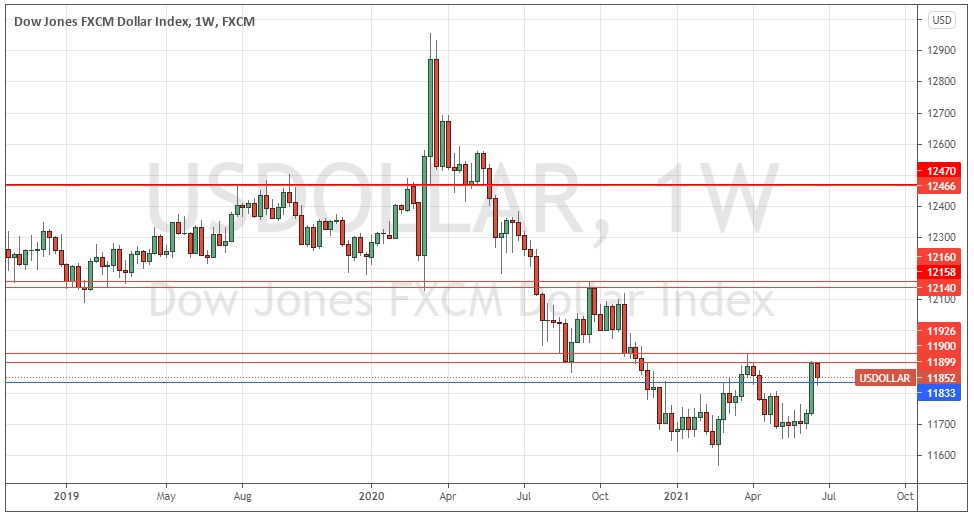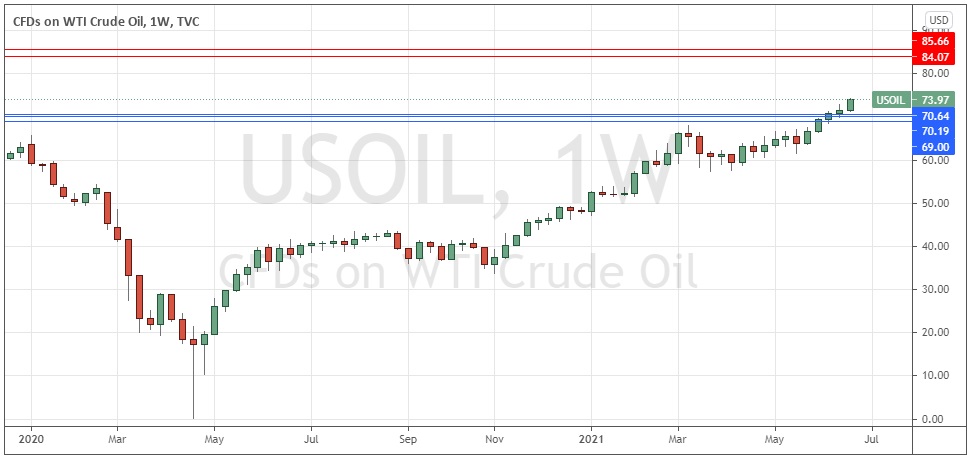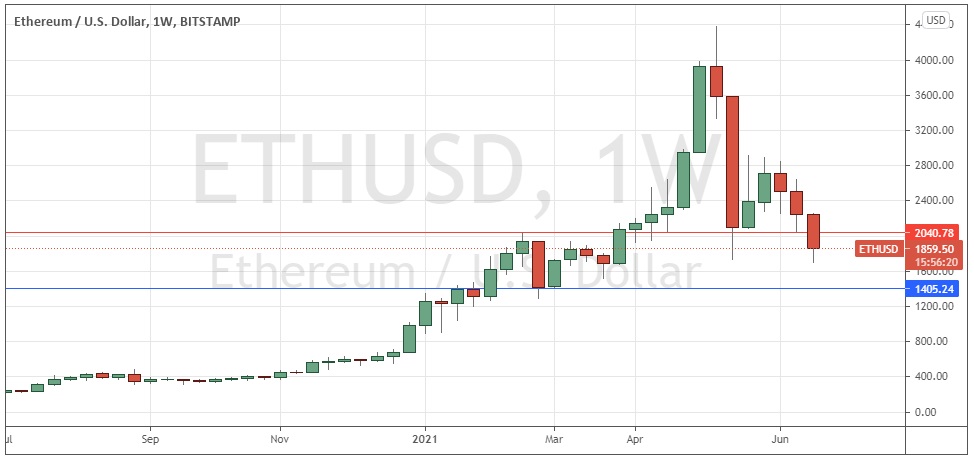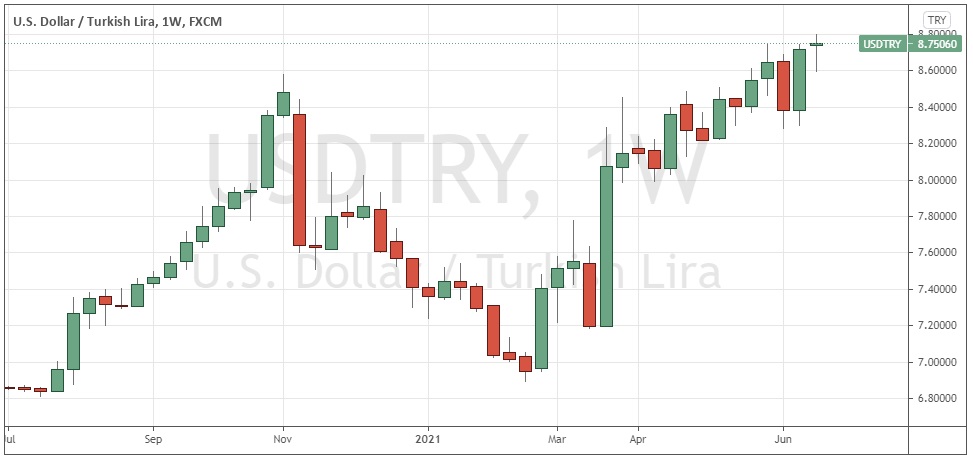The difference between success and failure in Forex trading is very likely to depend mostly upon which currency pairs you choose to trade each week and in which direction, and not on the exact trading methods you might use to determine trade entries and exits.
When starting the trading week, it is a good idea to look at the big picture of what is developing in the market as a whole and how such developments and affected by macro fundamentals and market sentiment.
There are a few strong or long-term trends left in the market: U.S. stock markets and WTI Crude Oil are reaching long-term highs, while major cryptocurrencies are beginning to break down with firm bearish momentum.
Big Picture 27th June 2021
Last week’s Forex market saw the strongest rise in the relative value of the Australian dollar and the strongest fall in the relative value of the Japanese yen. Volatility in the Forex market rose sharply after the FOMC release on Wednesday.
I wrote in my previous piece last week that the best trades were likely to be short of the EUR/USD and AUD/USD currency pairs. Unfortunately, the short-term bearish trend reversed right at the weekly open, with EUR/USD giving an exit signal when down by 1.01% and AUD/USD when down by 0.94%. This produced an averaged loss of 0.98%. However, there were profitable short-term trading opportunities in the USD/TRY currency pair, as I expected.
Fundamental Analysis & Market Sentiment
The headline takeaway from last week was that despite recent concern over inflation and the prospect of U.S. rate hikes sooner than had been expected, stock markets are still bullish (especially the U.S. stock market which is seeing new all-time highs) as is crude oil. The Forex market has been less predictable.
Last week saw a monthly policy release from the Bank of England which contained no surprises or rate adjustments and sent the pound somewhat lower, but it was not an especially strong move.
The main event this coming week will be the release of U.S. non-farm payrolls data, a key metric indicating the relative health of the U.S. economy.
Last week saw the global number of confirmed new coronavirus cases and deaths rise for the first time in eight weeks, suggesting that the spread of the more highly infectious Delta (Indian) variant is beginning to have an impact on global numbers even though approximately 22.6% of the global population has received at least one vaccination to date.
Excepting extremely small nations, the fastest progress towards herd immunity has taken place in Iceland, Kuwait, Canada, Israel, Bhutan, the U.K., and Chile, which have each inoculated more than 63% of their respective populations. Immunization is now proceeding more quickly in the European Union than it is in the U.S. although the U.S. is ahead of the E.U. with 53% of its population having received at least one shot of a vaccine, while the E.U. has vaccinated 49% of its population. A few nations have begun vaccinating older children, but this is mostly being done on only a limited basis.
The strongest growth in new confirmed coronavirus cases right now is happening in Bangladesh, Burma, Colombia, Cuba, Fiji, Guatemala, Indonesia, Kuwait, Kyrgyzstan, Mexico, Oman, Panama, Russia, South Africa, Tunisia, Uzbekistan, and the U.K. The U.K.’s case seems unusual as it has such a high vaccination rate, although the under-30s within Britain’s ageing population are still mostly unvaccinated.
Technical Analysis
U.S. Dollar Index
The weekly price chart below shows the U.S. Dollar Index printed a small bearish inside candlestick last week. However, it should be noted that both the nearby support and resistance levels held, and that the index is just below its level from three months ago but above its level from six months ago, which shows that a long-term bullish trend is just about in force. Overall, next week’s price movement in the U.S. dollar still looks more likely to be upwards than downwards, provided that the support level at 11833 continues to hold up. This suggests that trades long of the USD against other currencies are most likely to be appropriate over this coming week.
S&P 500 Index
The S&P 500 Index printed a strong bullish engulfing candlestick which closed very near the top of its weekly range at an all-time high price. These are simply very bullish signs which indicate that a further rise next week is more likely than not to happen. Since the coronavirus crash of 2020, this major U.S. equity index has risen by an astonishing 95%, which is an excellent return over barely fifteen months. The S&P 500 Index remains a buy.
WTI Crude Oil
WTI Crude Oil printed a strong, good-sized bullish candlestick last week which closed very near its high, making a new 2.5-year high price. These are simply very bullish signs which indicate a further rise next week is more likely than not to happen. WTI Crude Oil remains a buy but due to high swap fees traders may prefer not to hold this instrument overnight.
Ethereum
Ethereum printed a reasonably large bearish candlestick last week which broke below pivotal key support confluent with the major round number at $2,000. It was a bad week for cryptocurrencies in general, which have broadly been in retreat for several weeks now. These are bearish signs, so I think Ethereum is more likely than not to move down to at least the closest key support level at $1,405.
USD/TRY
The USD/TRY currency pair printed another bullish candlestick last week which closed at an all-time high weekly closing price. These are bullish signs, boosted by the fact that the USD is still the strongest major currency, while the Turkish lira is a basket case subject to endless long-term depreciation due to a lack of confidence in the ability of Turkey’s central bank to operate effectively. These two factors make longs attractive here, but traders should always beware of high spreads and even higher volatility, with the pair prone to strong pullbacks even within strong trends.
Bottom Line
I see the best likely opportunities in the financial markets this week as being long of the S&P 500 Index and WTI Crude Oil, and short of Ethereum targeting $1,405. Traders may also find short-term opportunities going long on the USD/TRY currency pair.






